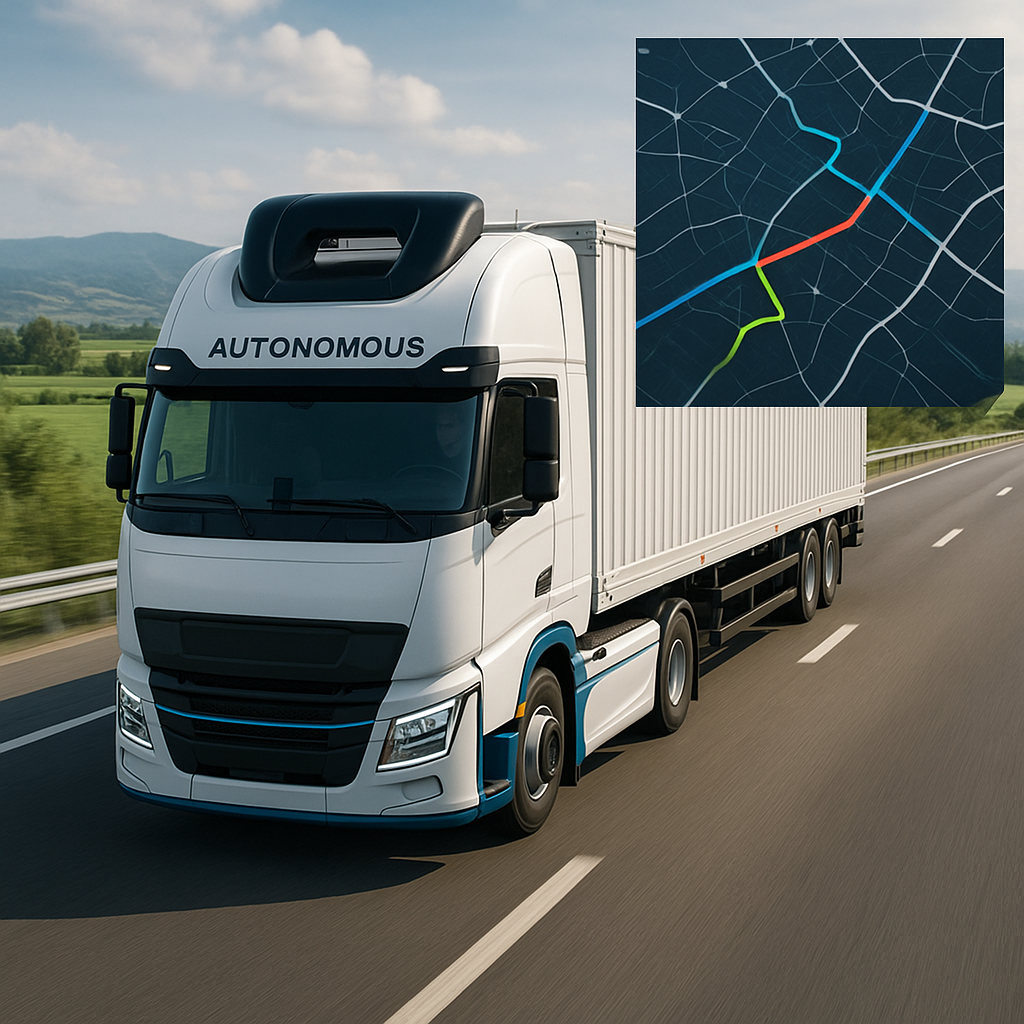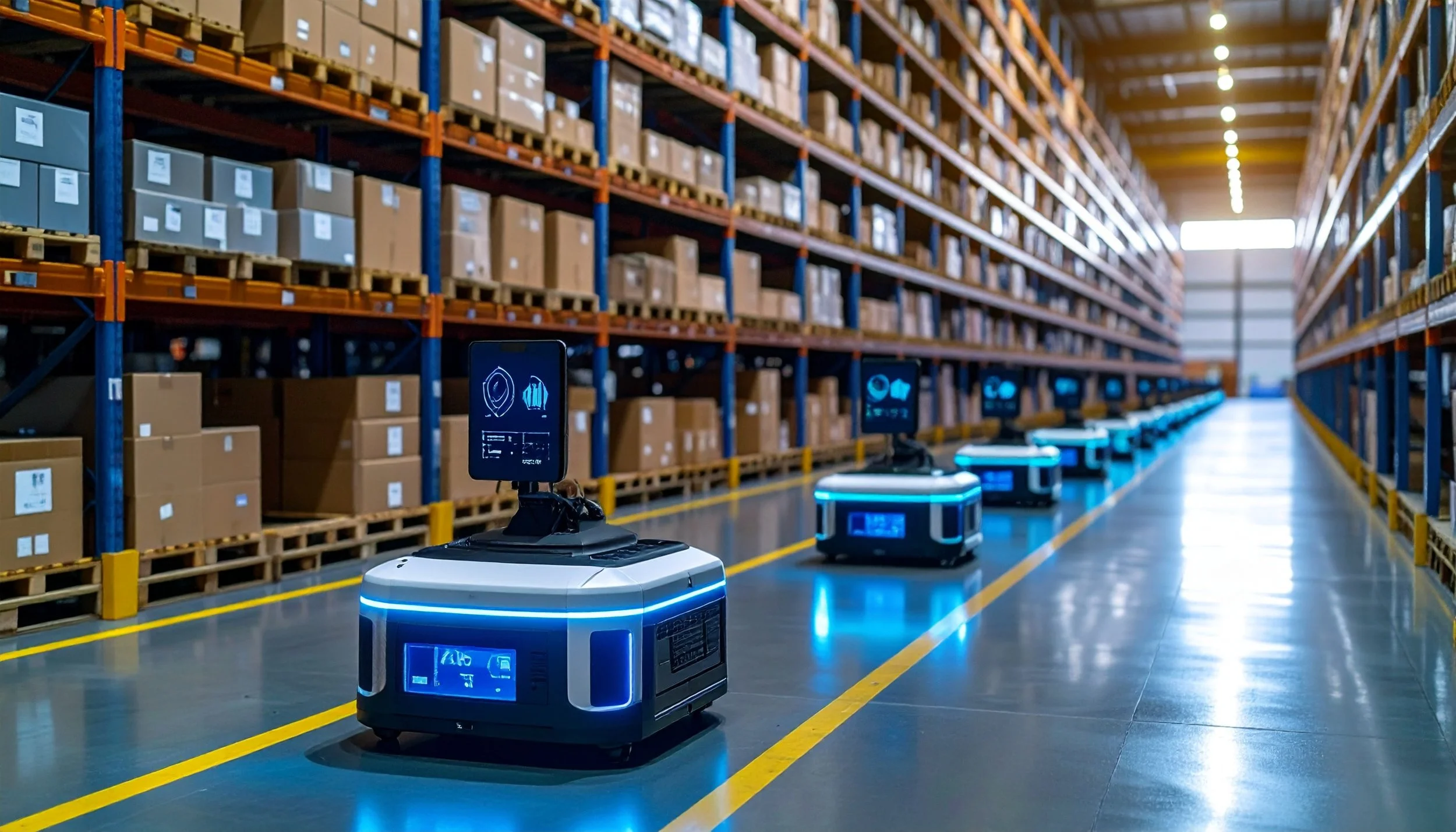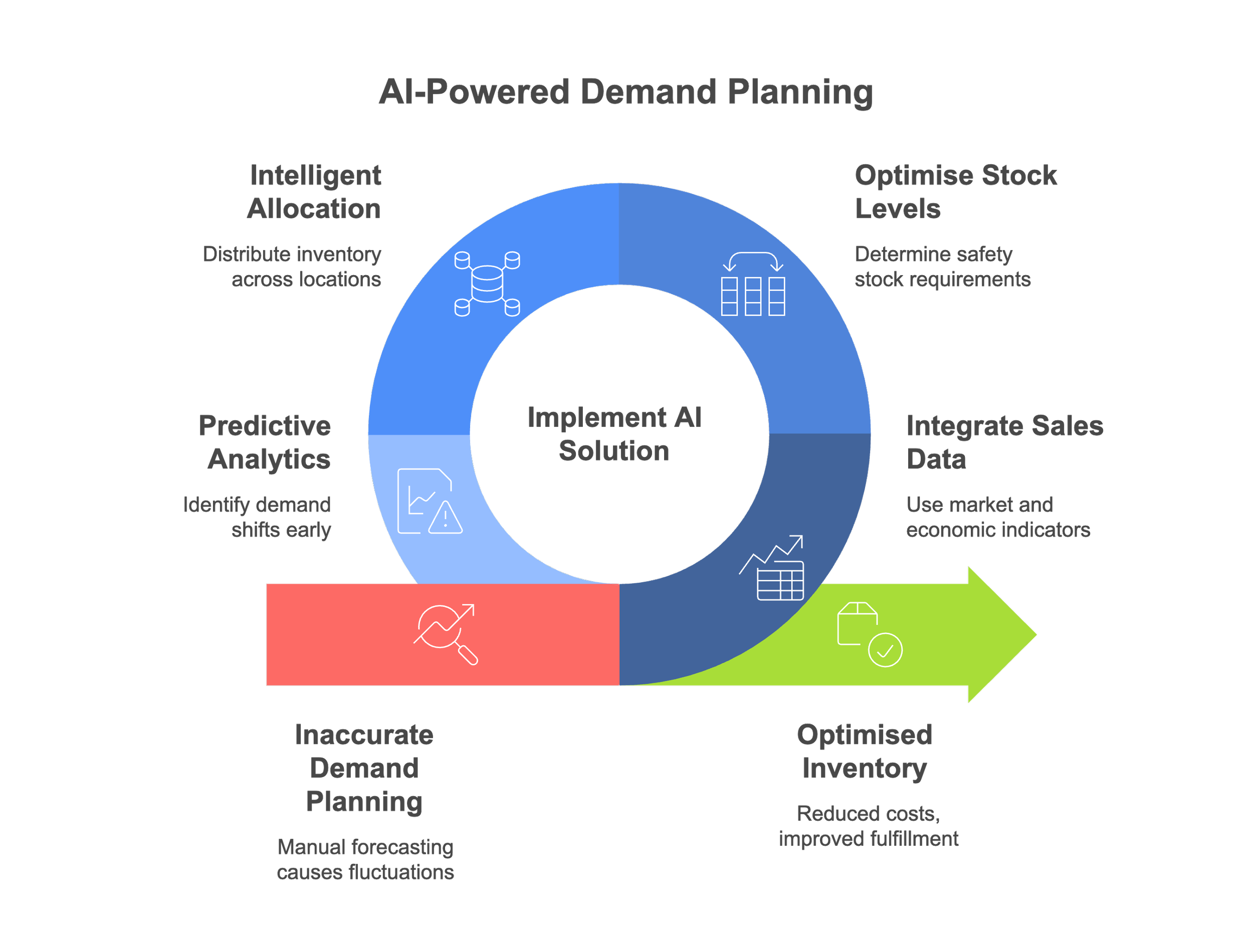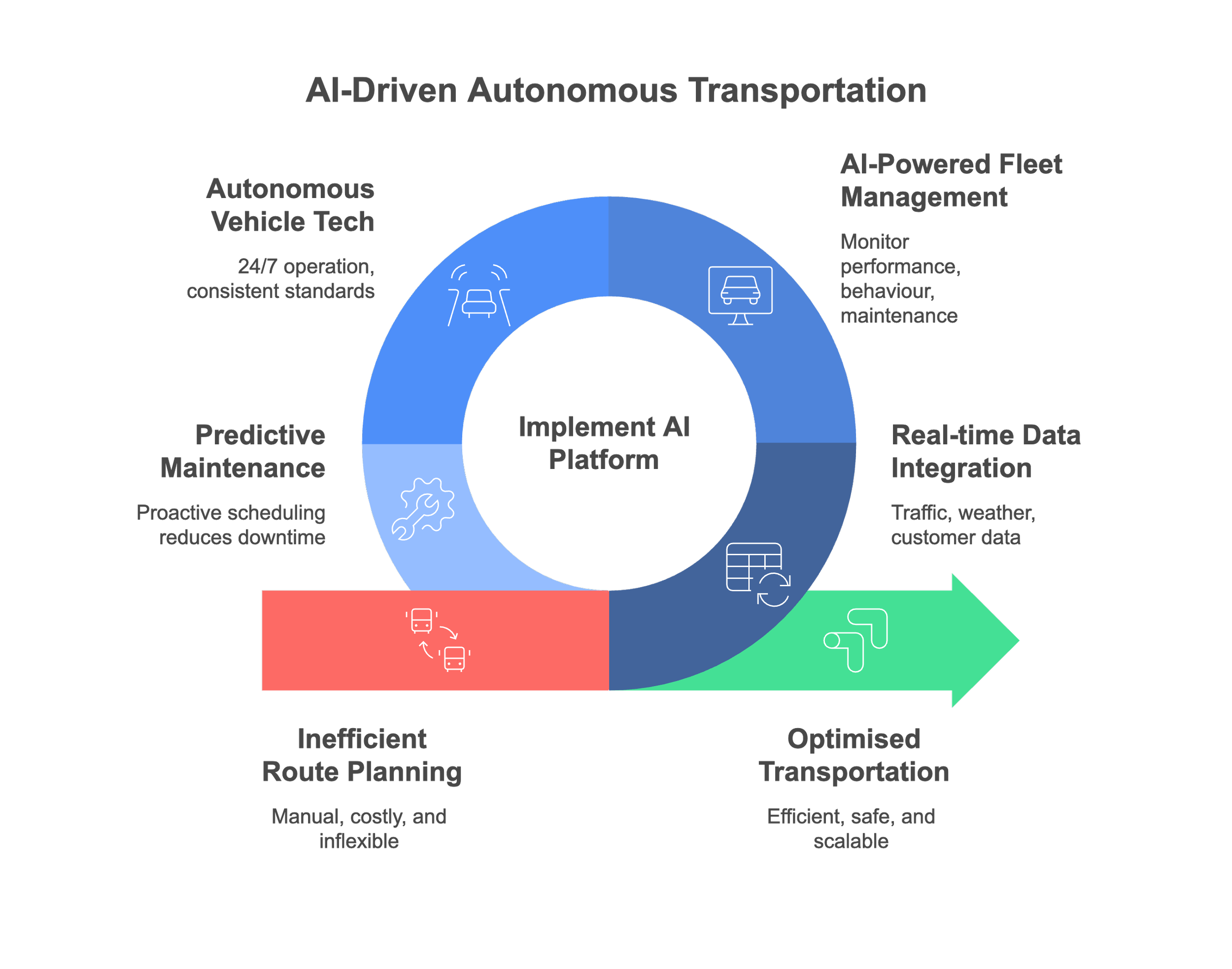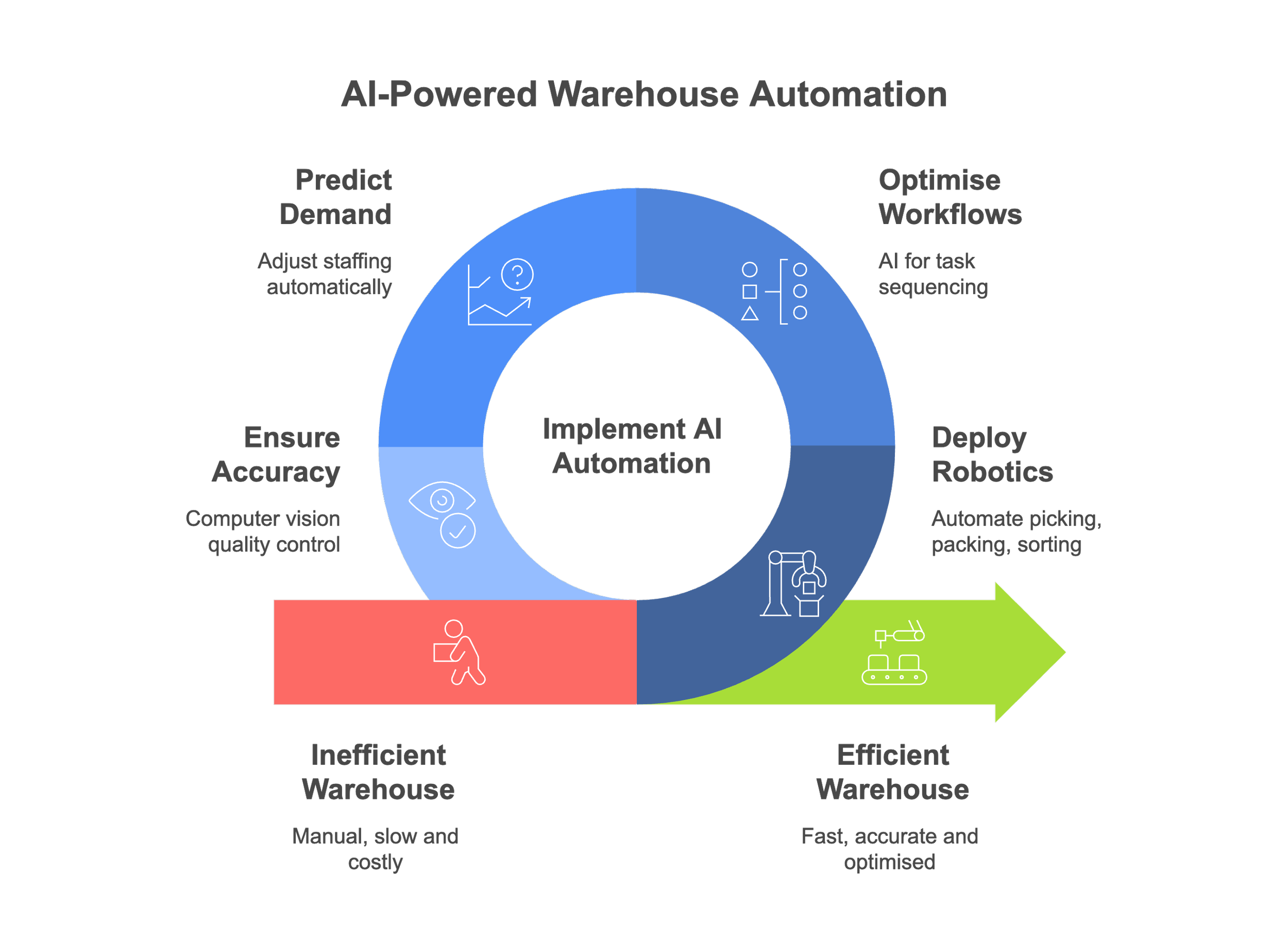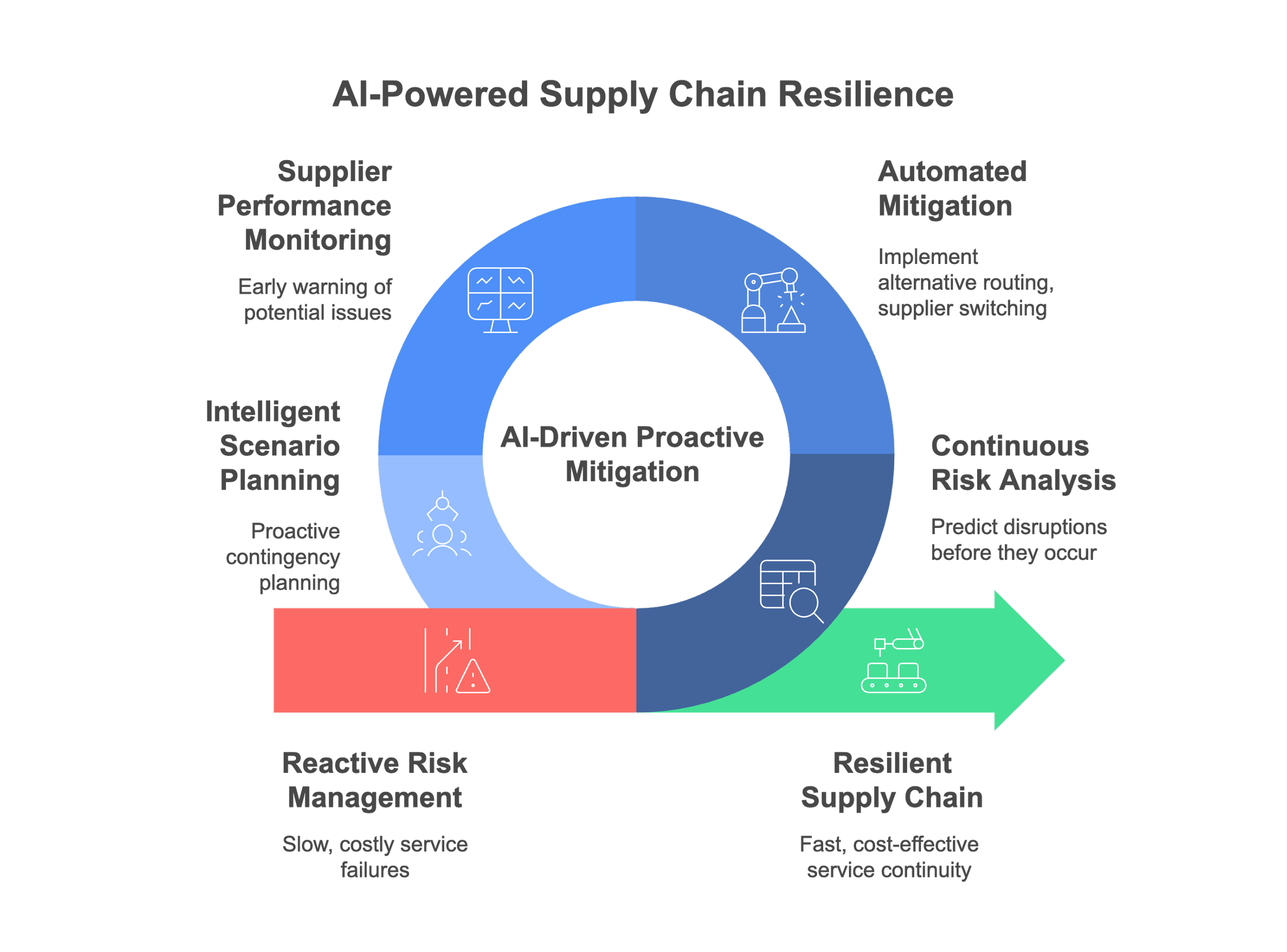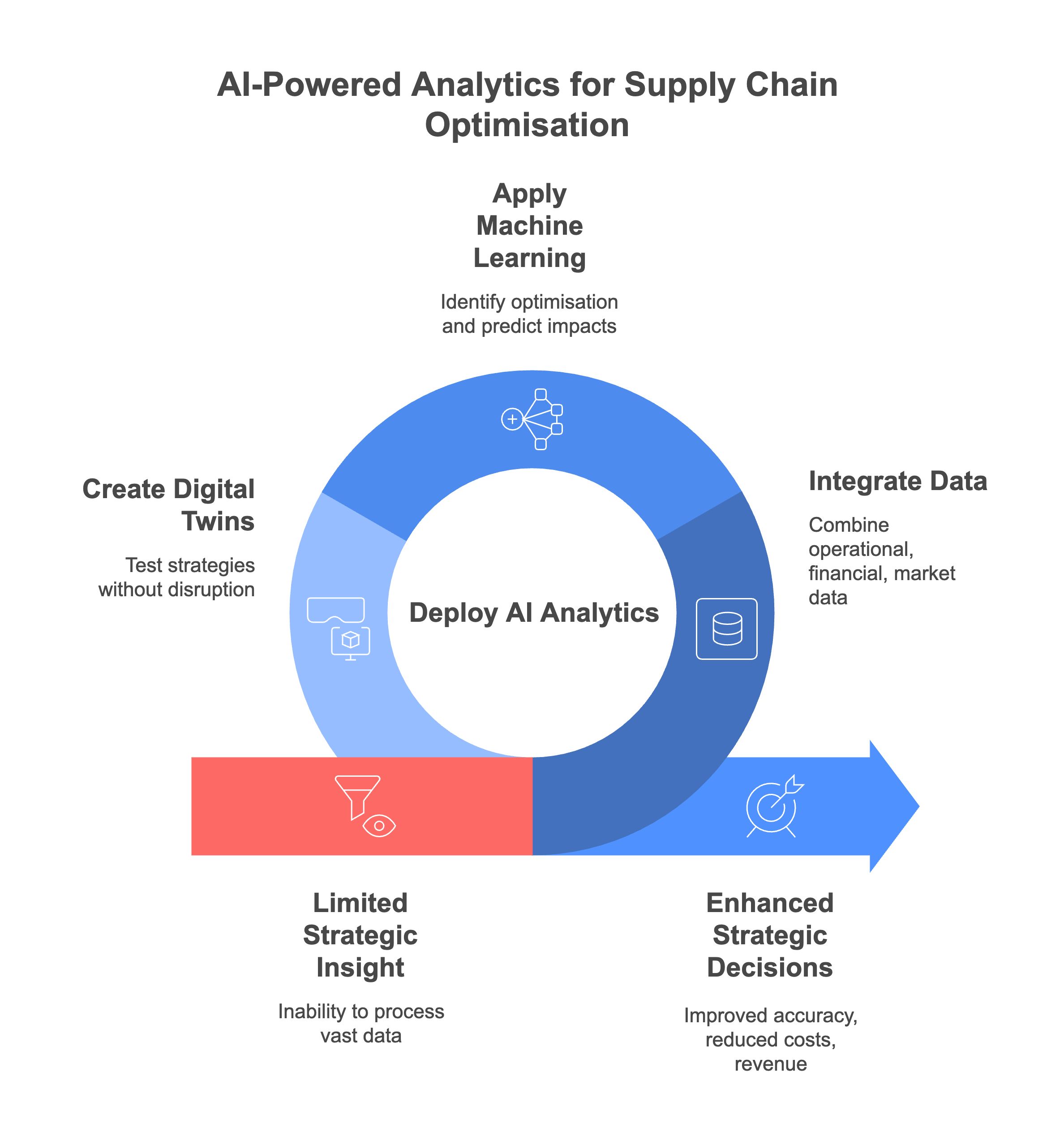
Transform Global Commerce
AI-Powered Supply Chain Excellence for Resilient Operations

Logistics Intelligence: AI-Powered Networks for Resilient Global Commerce
Global supply chains serving Asia-Pacific markets face unprecedented complexity requiring sophisticated coordination and optimisation capabilities. AI enables predictive planning, autonomous operations, and enhanced visibility across multi-modal transportation networks. Leading organisations achieve 20-40% operational cost reductions and 30-50% delivery performance improvements through intelligent automation. The transformation demands AI integration across demand planning, transportation optimisation, warehouse automation, and risk management to maintain service excellence while adapting to volatile market conditions and customer requirements.
The following six essential AI scenarios show how digibus.ai can help logistics organisations capture these operational advantages:

Ready to Optimise your Global Operations with Intelligent Solutions?
Managing complex supply chains across Asia-Pacific markets requires sophisticated coordination that traditional approaches can't deliver. digibus.ai helps logistics organisations harness AI to optimise operations, enhance resilience, and improve service while achieving outstanding results: reduction in operational costs, improvement in delivery performance, and enhanced network visibility that drives customer satisfaction.
We understand the logistics landscape – from multi-modal transportation and warehouse operations to regulatory compliance and customer service requirements. Our AI solutions are designed for supply chain environments, delivering practical improvements that enhance performance and profitability.
Why logistics leaders partner with digibus.ai:
Supply chain expertise with deep operational knowledge
AI solutions built for logistics and transportation
Proven methodology with measurable performance improvements
Comprehensive support from assessment to full implementation
Transform your Supply Chain Operations, Enhance Customer Service and Build Resilient Networks that Drive Competitive Advantage
Intelligent Demand Planning and Inventory Optimisation
AI-powered demand forecasting systems analysing market signals, customer behaviour, and external factors to optimise inventory positioning and reduce supply chain costs whilst maintaining service levels.
CHALLENGE WITHOUT AI
Traditional demand planning methods rely on historical patterns whilst manual forecasting processes cannot accurately predict demand fluctuations caused by market volatility and unexpected events.
AI SOLUTION OPPORTUNITY
Deploy advanced machine learning algorithms integrating sales data, market intelligence, economic indicators, and external signals generating highly accurate demand forecasts whilst AI-powered inventory optimisation systems.
IMPACTED CAPABILITIES
Demand forecasting and planning, inventory management and optimisation, supply chain network design, customer service and order fulfillment, supplier relationship management, working capital management, performance measurement.
TANGIBLE BUSINESS BENEFITS
Inventory cost: Decrease in total inventory carrying costs through optimised stock levels whilst service level enhancement delivers order fulfillment rates through better prediction.
Service level: Order fulfillment rates through better demand prediction and proactive inventory management whilst supply chain efficiency gains include reduction in expedited shipping costs.
Supply chain efficiency: Reduction in expedited shipping costs and emergency procurement expenses whilst customer satisfaction improvement results from consistent product availability.
Customer satisfaction: Consistent product availability and reliable delivery performance strengthening long-term relationships whilst operational agility enhancement enables faster response.
Cost optimisation: Reduced warehousing expenses and improved asset utilisation whilst operational agility enables faster response to market changes providing competitive advantage.
Autonomous Transportation and Route Optimisation
AI-driven transportation management systems optimising routing, scheduling, and fleet utilisation whilst incorporating autonomous vehicle technologies to enhance delivery efficiency and reduce operational costs.
CHALLENGE WITHOUT AI
Manual route planning cannot effectively optimise complex multi-stop deliveries whilst traditional transportation management approaches fail to dynamically adjust to real-time conditions.
AI SOLUTION OPPORTUNITY
Implement intelligent transportation management platforms combining machine learning algorithms with real-time traffic data whilst AI-powered fleet management systems monitor vehicle performance.
IMPACTED CAPABILITIES
Transportation planning and optimisation, fleet management and maintenance, route planning and execution, driver management and safety, fuel management and cost control, customer communication, regulatory compliance.
TANGIBLE BUSINESS BENEFITS
Transportation cost: Decrease in total delivery costs through optimised routing whilst fuel efficiency improvements deliver additional cost savings through reduced mileage.
Delivery performance: On-time delivery rates and reduced transit times improving customer satisfaction whilst fleet efficiency gains deliver improvement in asset utilisation.
Fleet efficiency: Improvement in asset utilisation through better scheduling whilst safety improvement results from AI-powered monitoring and autonomous vehicle technologies.
Safety improvement: AI-powered monitoring and autonomous vehicle technologies reduce accidents whilst scalability benefits enable expansion of delivery capacity.
Environmental impact: Lower carbon emissions through optimised routing supporting sustainability goals whilst scalability enables capacity expansion without proportional fleet increases.
Intelligent Warehouse Operations and Fulfillment Automation
AI-enhanced warehouse management systems automating picking, packing, and sorting operations whilst optimising layout, staffing, and workflow processes to maximise throughput and accuracy.
CHALLENGE WITHOUT AI
Manual warehouse operations struggle to meet increasing volume demands whilst traditional warehouse management systems cannot effectively optimise complex workflows.
AI SOLUTION OPPORTUNITY
Deploy intelligent warehouse management systems incorporating robotics, computer vision, and machine learning automating picking whilst AI-powered workflow optimisation algorithms determine optimal task sequencing.
IMPACTED CAPABILITIES
Warehouse operations and management, order fulfillment and processing, inventory management and control, workforce planning and optimisation, quality control and assurance, facility layout, technology integration.
TANGIBLE BUSINESS BENEFITS
Operational efficiency: Increase in warehouse throughput through automation enabling handling of greater volumes whilst labour cost reduction delivers decrease in warehouse expenses.
Labour cost: Decrease in warehouse labour expenses through automation whilst accuracy enhancement includes picking accuracy through AI-powered quality control systems.
Accuracy enhancement: Picking accuracy through AI-powered quality control and automated verification systems whilst order processing speed improvement includes reduction in cycle times.
Order processing: Reduction in order cycle times from receipt to shipment whilst capacity optimisation enables increase in processing volume within existing facilities.
Cost per shipment: Reduction from improved efficiency and reduced error rates eliminating costly corrections whilst capacity optimisation enables substantial volume increases.
Predictive Supply Chain Risk Management and Resilience
AI-powered risk monitoring systems identifying potential supply chain disruptions, assessing their impact, and automatically implementing mitigation strategies to maintain operational continuity and service levels.
CHALLENGE WITHOUT AI
Traditional risk management approaches are reactive whilst manual monitoring of supplier performance and external risk signals cannot process volume and complexity.
AI SOLUTION OPPORTUNITY
Implement comprehensive risk monitoring platforms continuously analysing supplier performance data whilst machine learning algorithms assess disruption scenarios and automatically recommend mitigation strategies.
IMPACTED CAPABILITIES
Risk assessment and monitoring, supplier relationship management, contingency planning and business continuity, crisis management and response, supply chain network design, insurance and risk transfer, stakeholder communication.
TANGIBLE BUSINESS BENEFITS
Disruption cost: Decrease in losses from supply chain interruptions through early detection whilst service continuity improvement maintains service levels during disruption events.
Service continuity: Service levels during disruption events that would traditionally cause significant failures whilst recovery time acceleration includes faster return to operations.
Recovery time: Faster return to normal operations through automated response systems whilst supplier relationship enhancement results from collaborative risk management approaches.
Supplier relationship: Collaborative risk management approaches strengthening partnerships whilst insurance and risk management cost reduction includes lower premiums.
Competitive advantage: Superior supply chain reliability differentiating service offerings whilst insurance cost reduction includes reduced claims through demonstrated mitigation capabilities.
Advanced Analytics for Strategic Decision Making and Network Optimisation
Comprehensive AI-powered analytics platforms providing deep insights into supply chain performance, customer behaviour, and market dynamics to inform strategic planning and network optimisation decisions.
CHALLENGE WITHOUT AI
Traditional supply chain analytics cannot effectively process vast amounts of operational data whilst manual analysis is time-intensive and provides outdated insights.
AI SOLUTION OPPORTUNITY
Deploy comprehensive analytics platforms integrating operational data, financial metrics, customer feedback, and external market intelligence generating actionable strategic insights whilst machine learning algorithms identify opportunities.
IMPACTED CAPABILITIES
Strategic planning and analysis, network design and optimisation, performance measurement and reporting, financial analysis and cost management, market research and competitive intelligence, business development, technology investment.
TANGIBLE BUSINESS BENEFITS
Strategic decision: Better accuracy in network optimisation and investment decisions whilst cost optimisation achieves reduction in total supply chain costs.
Cost optimisation: Reduction in total supply chain costs through identification of efficiency opportunities whilst revenue enhancement identifies new service opportunities.
Revenue enhancement: New service opportunities and market expansion possibilities whilst performance measurement enhancement provides real-time visibility into key metrics.
Performance measurement: Real-time visibility into key metrics and automated reporting improving management decision-making whilst competitive intelligence improvement enables faster response.
Investment optimisation: Capital allocation decisions based on comprehensive analysis delivering maximum return whilst competitive intelligence enables rapid response to threats.
Sustainable Operations and Regulatory Compliance Optimisation
AI-enabled sustainability management systems optimising carbon footprint, ensuring regulatory compliance, and enhancing environmental performance whilst maintaining operational efficiency and cost effectiveness.
CHALLENGE WITHOUT AI
Increasing regulatory requirements create complex compliance challenges whilst traditional approaches cannot effectively balance environmental objectives with operational efficiency.
AI SOLUTION OPPORTUNITY
Implement intelligent sustainability management platforms continuously monitoring carbon emissions whilst machine learning algorithms optimise routing and operational processes minimising environmental impact.
IMPACTED CAPABILITIES
Environmental management and sustainability, regulatory compliance and reporting, carbon footprint monitoring and reduction, operational process optimisation, stakeholder communication and engagement, risk management, strategic planning.
TANGIBLE BUSINESS BENEFITS
Environmental impact: Decrease in carbon emissions through optimised routing supporting sustainability goals whilst regulatory compliance cost reduction delivers decrease in compliance management expenses.
Regulatory compliance: Decrease in compliance management expenses through automated monitoring whilst operational efficiency enhancement identifies sustainability improvements reducing costs.
Operational efficiency: Sustainability improvements that also reduce costs creating win-win outcomes whilst brand reputation improvement results from demonstrated environmental leadership.
Brand reputation: Demonstrated environmental leadership attracting environmentally conscious customers whilst regulatory risk mitigation prevents costly violations.
Competitive differentiation: Premium positioning for sustainable logistics services commanding higher margins whilst regulatory risk mitigation prevents penalties through proactive compliance monitoring.


